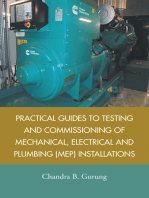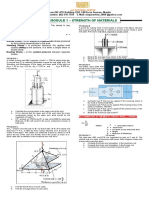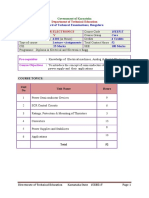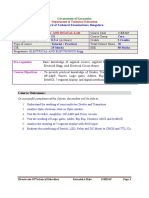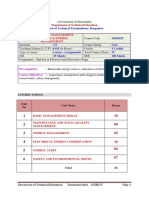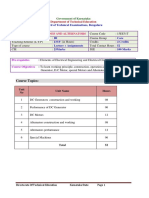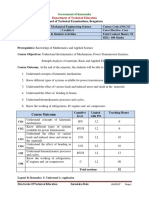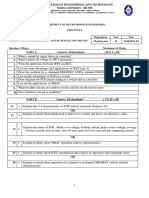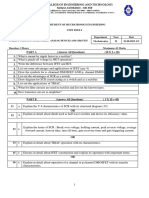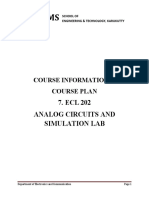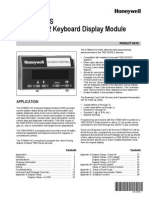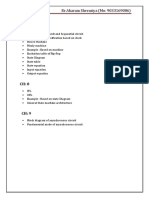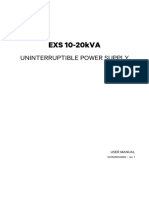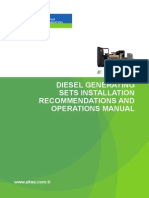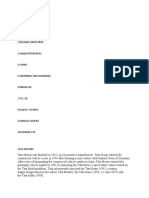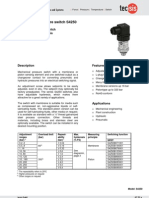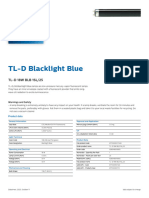Department of Technical Education
Department of Technical Education
Uploaded by
Vijaya BhaskerCopyright:
Available Formats
Department of Technical Education
Department of Technical Education
Uploaded by
Vijaya BhaskerOriginal Title
Copyright
Available Formats
Share this document
Did you find this document useful?
Is this content inappropriate?
Copyright:
Available Formats
Department of Technical Education
Department of Technical Education
Uploaded by
Vijaya BhaskerCopyright:
Available Formats
Government of Karnataka
Department of Technical Education
Board of Technical Examinations, Bengaluru
Course Title: POWER ELECTRONICS Course Code : 15EE51T
Semester :V Course Group : Core
Teaching Scheme (L:T:P) :4:0:0 (in Hours) Credits : 4 Credits
Type of course :Lecture +Assignments Total Contact Hours : 52
CIE : 25 Marks SEE : 100 Marks
Programme: Diploma in Electrical and Electronics Engg.
Pre-requisites : Knowledge of Electrical machines, Analog & Digital Electronics
Course Objectives : To introduce the concept of semiconductors devices for high
power supply and their applications
COURSE TOPICS:
Unit
Unit Name Hours
No
1 Power Semiconductor Devices 9
2 SCR Control Circuits 6
3 Ratings, Protection & Mounting of Thyristors 3
4 Converters 13
8
5 Power Supplies and Stabilizers
13
6 Applications
Total 52
Directorate of Technical Education Karnataka State 15EE51T Page 1
Course Outcomes:
On successful completion of the course, the student will be able to:
1. Understand the basics of power semiconductor devices
2. Explain Thyristor control circuits
3. Generalize the protection of Thyristors
4. Analyze the working of DC and AC Converters
5. Describe the operation of power supplies.
6. Illustrate the applications of power Electronics.
Composition of Educational Components
Questions for CIE and SEE will be designed to evaluate the various educational components
(Bloom’s Taxonomy) such as:
Sl. Total Marks
Educational Component Weightage (%)
No. (Out of 145)
1 Remembering 10 15
2 Understanding 45 65
3 Application 45 65
Total 100 145
Directorate of Technical Education Karnataka State 15EE51T Page 2
Course Outcome linkage to Cognitive Level
Cognitive Level Legend: R- Remember, U- Understand, A- Application
CL Linked Teaching Hrs
Course Outcome PO
Understand the basics of power 2,10 9
CO1 R/U
semiconductor devices
CO2 Explain Thyristor control circuits U/A 2,4,10 6
Generalize the protection of 2,10 3
CO3 R/U
Thyristors
Analyze the working of DC and 4,10 13
CO4 U/A
AC Converters
Describe the operation of power 4,10 8
C05 U/A
supplies.
Illustrate the applications of power 13
C06 U/A 4,10
Electronics.
Total sessions 52
Directorate of Technical Education Karnataka State 15EE51T Page 3
Course Content and Blue Print of Marks for SEE:
Questions to Questions to
be set for be set for
Max.
(5marks ) (10marks) Marks
Unit Marks
Unit Name Hour PART - A PART - B weightage
No per
(%)
Unit
R U A R U A
Understand the
basics of power
1 9 25 1 1 0 0.5 1 0 17
semiconductor
devices
2 Explain Thyristor
6 15 0 1 0 0 1 10
control circuits
Generalize the
3 protection of 3 10 1 0 0 0.5 0 7
Thyristors
Analyze the working
4 of DC and AC 13 35 0 1 1 0 1 1.5 24
Converters
Describe the
5 operation of power 8 20 0 1 0 1 0.5 14
supplies.
Illustrate the
6 applications of power 13 40 0 1 1 0 1 2 28
Electronics.
Total 9 10 100
52 145
(45 Marks) (100 Marks)
Directorate of Technical Education Karnataka State 15EE51T Page 4
Course-PO Attainment Matrix
Programme Outcomes
Course
1 2 3 4 5 6 7 8 9 10
POWER
- 2 - 3 - - - - - 3
ELECTRONICS
Level 3- Highly Addressed, Level 2-Moderately Addressed, Level 1-Low Addressed.
Method is to relate the level of PO with the number of hours devoted to the COs which address the given PO.
If >40% of classroom sessions addressing a particular PO, it is considered that PO is addressed at Level 3
If 25 to 40% of classroom sessions addressing a particular PO, it is considered that PO is addressed at Level 2
If 5 to 25% of classroom sessions addressing a particular PO, it is considered that PO is addressed at Level 1
If < 5% of classroom sessions addressing a particular PO, it is considered that PO is considered not-addressed.
Directorate of Technical Education Karnataka State 15EE51T Page 5
Course Content:
Unit –I
POWER SEMICONDUCTOR DEVICES– Concept of power electronics, Power
electronic devices-Power diode- Structure, Characteristics, types and applications, Power
transistor-types, switching characteristics and applications, MOSFET-operation, transfer
characteristics and applications, IGBT –structure and applications, SCR-layer diagram,
transistor analogy, Characteristics, LASCR –structure and operation, GTO Triac-
characteristics, triggering modes, DIAC- Characteristics, operation and applications
Unit –II
SCR CONTROL CIRCUITS- Methods of turning on the SCR, General layout of firing
circuit, R and RC Firing circuits, Pulse triggering using UJT, Digital firing scheme,
Commutation and types.
Unit –III
RATINGS, PROTECTION & MOUNTING OF THYRISTORS- Voltage and current
ratings of SCR, Protection of SCR against Over voltage, Over current, di/dt and dv/dt,
Types of Mounting of SCRs
Unit –IV
CONVERTERS - Types of converters, Phase control, Full controlled bridge converter, dual
converters, three phase converters, Choppers-definition, step up and step down choppers,
different chopper configurations, inverters-definition ,VSI and CSI, Half bridge inverter and
full bride inverter, three phase bridge inverter, cyclo converter-midpoint cyclo converter, step
up and step down cyclo converter, advantages and disadvantages
Unit –V
POWER SUPPLIES AND STABILIZERS- SMPS and operation, Buck, Boost, Buck-
Boost and Flyback converter, power line disturbances, sources and effects power
conditioners, Operation of relay type AC voltage stabilizer, advantages and disadvantages of
Relay type stabilizer, AC servo voltage stabilizer, advantages and disadvantages, UPS-
Battery size and required voltage for UPS, Offline UPS, Online UPS.
Unit –VI
APPLICATIONS- Power system applications- Static AC circuit breaker, interconnection
of renewable energy sources and energy storage systems to the utility, Grid Thyristor
switched capacitors and Thyristor switched inductors (Reactors).
Industrial applications -Switch mode welder, Voltage source series resonant inverters in
induction heating, solid state relay, speed control of shunt wound DC motor by armature
voltage control method, soft starting of Induction motor, static slip recovery system in
induction motor (static scherbius drive), speed control of Induction Motor by Variable
voltage frequency method
Domestic Applications-High frequency lighting system, SCR battery charger.
Directorate of Technical Education Karnataka State 15EE51T Page 6
Reference Books:
1. Power Electronics by Dr P S Bimbhra , Khanna Publishers, New Delhi
2. Industiial Electronics and Control Biswanath Paul PHI Publication Edition-II
3. Thyristorised power controllers GK Dubey
4. Power and industrial Electronics by Harish C Rai
5. Power electronics by Mohan Undeland & Robbins, Wiley Publications
6. Modern Power Electronics by P.C.Sen
7. Power Electronics – RaghunathRao,
8. Voltage Stabilizers and cut outs-Mc Sharma , BPB Pulications
9. Switch Gear and protection by J B Gupta , Katson Publication
e-Resources:
www.electricalengineeringinfo.com/2014/06/silicon...
Course Delivery:
The Course will be delivered through lectures, classroom interaction, animations, group
discussion, exercises and student activities, assignments.
Directorate of Technical Education Karnataka State 15EE51T Page 7
Course Assessment and Evaluation:
Course
To Max Evidence
What Frequency Outcom
Whom Marks Collected
es
Three IA tests
for Theory:
(Continuous Internal
(Average Blue
I A Tests 20 1 to 6
marks of Three Books
Evaluation)
Tests to be
Students
computed).
CIE
Direct Assessment
Student Report of
05 1 to 6
Student Activity 2 pages
Activity
TOTAL 25
(Semester End
Examination)
Answer
Students
End Of the
SEE
End Exam 100 Scripts at 1 to 6
Course
BTE
Student Feedback on Middle Of
Assessment
Feed Back Forms 1 to 6
course The Course
Students
Indirect
End Of The
End Of Course Survey Questionnaires 1 to 6
Course
*CIE – Continuous Internal Evaluation *SEE – Semester End Examination
Note: I.A. test shall be conducted for 20 marks. Average marks of three tests shall be
rounded off to the next higher digit.
Note to IA verifier: The following documents to be verified by CIE verifier at the end of
semester
1. Blue books ( 20 marks)
2. Student suggested activities report for 5 marks evaluated through appropriate rubrics.
3. Student feedback on course regarding Effectiveness of Delivery of instructions & Assessment
Methods.
Directorate of Technical Education Karnataka State 15EE51T Page 8
Course Contents with Lecture Schedule:
Lesson
No./ Duration
Contents
Session
No.
Unit I Introduction to power electronics 9 Hours
Describe the concept of power electronics
Draw the layer structure of power diode and explain it.
1. Draw V –I characteristics of power diode and explain. 01 Hour
List & explain types of power diodes and their applications
Ref: 1 Ref: 2
List the types of Power transistors, explain BJT switching
2. characteristics, BJT as a switch 01 Hour
Ref: 1
Explain the operation of N-channel enhancement MOSFET
and draw its transfer characteristic curve, application of 01 Hour
3.
MOSFET
Ref: 1
Draw and Explain the structure of IGBT and application of
IGBT Ref: 5 01 Hour
4.
Compare MOSFET, BJT and IGBT
Ref: 2
Draw the layer diagram of SCR and explain the concept of two
5. 01 Hour
transistor analogy of SCR. Ref: 1
Explain the static V-I characteristic curve of SCR, Enumerate
6. Reverse blocking , Forward blocking, forward conduction mode 01 Hour
Ref: 1
Define GTO. Explain the principle of operation and list its
applications. Ref: 1 01 Hour
7.
Draw the layer structure of LASCR and explain its operation
Ref: 2
Draw the layer structure and explain the operation of TRIAC
Draw V-I characteristics & explain 4-Modes of turn on of
8 01Hour
TRIAC, state the preferred mode of turn-on
Ref: 1, Ref: 2
Explain the operation of DIAC and draw its V-I characteristic
curve, application of DIAC. Ref: 1
9 Explain the construction & operation of UJT. 01Hour
Draw & explain the V-I characteristics of UJT
List the applications of UJT Ref: 2
UNIT II SCR CONTROL CIRCUITS 6 Hours
List and explain the methods of turn on of SCR 01 Hour
10 Draw and explain the general layout of firing circuit
Ref:3, Ref 1
Directorate of Technical Education Karnataka State 15EE51T Page 9
Draw R firing circuit and explain with wave forms. 01 Hour
11
Draw R-C firing circuit and explain with wave forms Ref:1
12 Draw synchronized UJT pulse trigger circuit and explain with 01 Hour
waveforms.
Ref:3, Ref 1
13 Draw the Digital firing scheme and explain with wave forms 01 Hour
Ref:3
14 Define commutation, 01 Hour
Explain line commutation, forced commutation and list the
methods of forced commutation
Ref:1, Ref:2
15 Explain Load commutation and complementary commutation 01 Hour
Ref:1
3
Unit III Ratings ,Protection & Mounting of Thyristors
Hours
16 Explain voltage and current ratings of SCR and Reliability of 01 Hour
SCR Define MTBF. Ref:1 Ref:7
17 Describe how SCR can be protected against overvoltage and 01 Hour
over current, di/dt & dv/dt. Ref:1
18 Explain the different types of mounting of SCR. Ref:1 01 Hour
13
Unit IV CONVERTERS
Hours
DC Converters
Explain the types of power electronic converters
List the advantages and disadvantages of power electronic
19 converters Ref:1 01 Hour
Explain single quadrant semi converter, two quadrant full
converter and dual converter. Ref:3
Explain smart power modules 01 Hour
20 Explain principle of phase control with waveforms for resistive
load. Ref:1
Explain single phase full converter RLE type with continuous 01 Hour
21
load current Ref:1
Draw the circuit diagram of single phase Dual converter and 01 Hour
22
explain the principle of operation. Ref 2
23 Explain the gating pulse requirement of 3 phase full converters 01 Hour
Ref 4
Draw the circuit diagram of three phase bride converter and 01 Hour
24
explain 180 conduction mode with wave forms. Ref:1
Define DC Chopper.
Draw the circuit of step down chopper and explain its operation 01 Hour
25
Draw the circuit of step up chopper and explain its operation
Ref:1
Draw the different chopper configurations- (A, B, C, D and E)
26 and explain them. 01 Hour
Ref:1
Directorate of Technical Education Karnataka State 15EE51T Page 10
A C Converters
Define inverter
27 List and explain the 2 main types of inverters ( VSI and CSI) 01 Hour
List the differences between VSI and CSI. Ref:2, Ref 4
Draw the circuit diagram of half bride inverter and its operation
with wave forms 01 Hour
28
Draw the circuit diagram of full bride inverter and its operation
with wave forms. Ref:1
Draw the circuit diagram of three phase 180 0 mode voltage 01 Hour
29
source inverter and its operation with wave forms. Ref:1
Define cycloconverter.
30 Draw the circuit of mid- point step down cyclo converter and 01 Hour
explain its operation with waveforms. Ref 2
Draw the circuit of mid- point step up cyclo converter and
31 explain its operation with waveforms. Ref: 1 01 Hour
List the advantages and disadvantages of cyclo converters Ref 2
Unit V POWER SUPPLIES AND STABILIZERS 8Hours
Draw the Block diagram of SMPS and explain its operation
32 List the applications of SMPS 01 Hour
Ref: 2
Draw the circuit diagram of Buck and boost converter (regulator)
33 and explain its operation. 01 Hour
Ref: 2
Draw the circuit diagram of Buck-boost and fly back converter
34 (regulator) and explain its operation. 01 Hour
Ref: 2
Define the different types of power line disturbances
List the sources and effects of power line disturbances 01 Hour
35
Describe how power conditioners provide effective suppressing
of some or all of these electrical disturbances Ref:5
Describe the operation of relay type AC voltage stabilizer with
the help of diagram. 01 Hour
36
List the advantages and disadvantages of Relay type stabilizer
Ref: 7, Ref: 8
Draw the diagram of AC servo voltage stabilizer and explain its
01 Hour
37 operation
List the advantages and disadvantages . Ref: 2
Define UPS,
38 01 Hour
Determine Battery size and required voltage for UPS. Ref:6
Draw the block diagram of offline UPS and explain its operation
39 Draw the block diagram of online UPS and explain its operation 01 Hour
Ref: 2
Unit VI APPLICATIONS 13 Hours
Draw the circuit diagram of static AC circuit breaker and 01 Hour
40
explain its operation with waveforms Ref: 1
Directorate of Technical Education Karnataka State 15EE51T Page 11
41 Explain the operation of Thyristor switched capacitors and 01 Hour
Thyristor switched inductors (Reactors) Ref: 5
42 Draw the circuit diagram and explain single phase high 01 Hour
frequency photo voltaic interface to grid Ref: 5
43 Draw and explain the circuit for interconnection of wind and 01Hour
hydro generator
44 Draw the block diagram of interconnecting energy storage 01Hour
systems for utility load levelling Ref: 5
45 Draw the block diagram & explain the operation of Switch mode 01 Hour
welder.
46 Draw the block diagram and explain the operation of Voltage 01 Hour
source series resonant inverters in induction heating Ref: 5
47 Explain speed control of shunt wound DC motor by armature 01 Hour
voltage control method. Ref: 2
48 Explain with circuit diagram soft starting of Induction motor
01 Hour
Ref: 5
Explain with circuit diagram static slip recovery Ref: 1
49 Explain speed control of Induction Motor by Variable voltage 01 Hour
frequency method. Ref 2
Draw the circuit diagram and explain the speed control of 3
50 phase slip ring induction motor by static variation of external 01 Hour
rotor resistance. Ref 1
51 Draw the circuit and explain the operation of DC Solid state
Relay using opto-coupler. 01 Hour
Draw the circuit and explain the operation of AC Solid state
Relay using opto-coupler. Ref 1
52 Draw the block diagram of High frequency lighting system and
explain its operation. 01 Hour
Draw the circuit & explain SCR charger circuit for 12 V battery.
Ref 5
Directorate of Technical Education Karnataka State 15EE51T Page 12
Student Activity (any one to be submitted with 3 pages self HAND WRITTEN report):
1. Identify various power switching devices used commercially and study their
applications
2. Study various control circuits used in Practise in converters & inverters
3. Study various ratings of power semiconductor devices and select it for a particular
application
4. Visit nearby MUSS and collect details of power electronic applications
5. Study commercially available power supplies
6. Prepare a report on application of power electronic devices in industries
MODEL OF RUBRICS / CRITERIA FOR ASSESSING STUDENT ACTIVITY ( Course Coordinator)
Dimen Scale Students score
sion (Group of five
students)
1 2 3 4 5 1 2 3 4 5
Unsatisfactory Developing Satisfactory Good Exemplary
1 Descriptor Descriptor Descriptor Descriptor Descriptor 3
2 Descriptor Descriptor Descriptor Descriptor Descriptor 2
3 Descriptor Descriptor Descriptor Descriptor Descriptor 5
4 Descriptor Descriptor Descriptor Descriptor Descriptor 4
Note: Concerned faculty (Course coordinator) must devise appropriate 14/4
rubrics/criteria for assessing Student activity for 5 marks =3.5
One activity on any one CO (course outcome) may be given to a group of FIVE students ≈4
Grand Average/Total
Example only: MODEL OF RUBRICS / CRITERIA FOR ASSESSING STUDENT ACTIVITY-
Task given- Industrial visit and report writing
Dimensi Scale Students score
on (Five students)
1 2 3 4 5 1 2 345
Unsatisfactory Developing Satisfactory Good Exemplary
1.Organi Has not Has Has Has Has 3
sation included included included included included all
relevant info few relev some relev many relev relevant
ant info ant info ant info info needed
2. Fulfill Does not Performs Performs Performs Performs 2
team’s perform any very little partial nearly all all duties of
roles & duties duties duties duties assigned
duties assigned team roles
3.Conclu Poor Less Partially Summarise Most 5
sion Effective effective s but not Effective
exact.
4.Conve Frequent More Some Occasional No Error 4
nsions Error Error Error Error
Total marks 14/4=3.5
≈4
Directorate of Technical Education Karnataka State 15EE51T Page 13
FORMAT OF I A TEST QUESTION PAPER (CIE)
Test/Date and
Semester/year Course/Course Code Max Marks
Time
Ex: I test/6th weak of V/VI SEM
20
sem 10-11 Am Year:
Name of Course coordinator :
Units:__ CO’s:____
Questio
Question MARKS CL CO PO
n no
1
2
3
4
Note: Internal Choice may be given in each CO at the same cognitive level (CL).
Directorate of Technical Education Karnataka State 15EE51T Page 14
MODEL QUESTION PAPER (CIE)
Test/Date and Time Semester/year Course/Course Code Max Marks
1st Test/ 6 th week, V SEM, E & E Engg Power Electronics
20
9 Feb 16, 10-11 AM Year: 2015-16 Course code: 15EE51T
Name of Course coordinator :
Units Covered :1 and 2
Course Outcomes : 1 and 2
Instruction :(1). Answer all questions
Question
Question CL CO PO
No.
1 List the types of power diode or Define GTO (2 Marks) R CO1 2
2 Explain the 4-Modes of turn on of TRIAC ( 4 marks)
Or
Explain the construction of UJT U CO1 2
3 Explain line commutation and forced commutation (5 marks)
Or
U CO2 4
Explain the methods of turn on of SCR
4 Draw R firing circuit and explain with wave forms (9 marks)
Or
Draw synchronized UJT pulse trigger circuit and explain with A CO2 4
waveforms
CL: Cognitive Level, R-Remember, U-Understand, A-Application, PO: Program Outcomes
Directorate of Technical Education Karnataka State 15EE51T Page 15
Sl. Total Marks
Educational Component Weightage (%)
No. (Out of 20)
1 Remembering 10 2
2 Understanding 45 9
3 Application 45 9
20
Total 100
Directorate of Technical Education Karnataka State 15EE51T Page 16
Model QUESTION Paper BANK:
Course Title: POWER ELECTRONICS Course Code: 15EE51T
CO1 - Understand the basics of power semiconductor devices
.Unit 1 -Introduction to power electronics
Cognitive Level: REMEMBER
1. Draw the layer structure of power diode
2. List types of power diode and their applications
3. List the types of Power transistors and their applications
4. Draw the transfer characteristic curve and list the applications of MOSFET
5. Draw the structure of IGBT and list the applications of IGBT
6. Draw the layer diagram of SCR
7. Enumerate Reverse blocking ,Forward blocking, forward conduction mode
8. Define GTO and list its applications
9. Draw the layer structure of TRIAC and list its applications
10. state the preferred modes of turn-on of TRIAC
11. Draw the V-I characteristic curve of DIAC and list its applications
12. Draw the layer diagram of UJT and list the applicationsof UJT
Cognitive Level: UNDERSTAND
1. Describe the concept of power electronics.
2. Draw V –I characteristics of power diode and explain
3. Explain BJT switching characteristics
4. Explain with circuit diagram the operation of BJT as a switch
5. Explain the operation of N-channel enhancement MOSFET
6. Draw and Explain the structure of IGBT
7. Draw the layer diagram of SCR and explain the concept of two transistor analogy
8. Explain the static V-I characteristic curve of SCR
9. Explain the principle of operation GTO
10. Draw the layer structure of LASCR and explain its operation
11. Draw V-I characteristics & explain 4-Modes of turn on of TRIAC
12. Explain the operation of DIAC
13. Explain the construction of UJT
14. Draw & explain the V-I characteristics of UJT
15. List the differences between MOSFET, BJT and IGBT
Directorate of Technical Education Karnataka State 15EE51T Page 17
CO2- Explain Thyristor control circuits
Unit 2 - SCR CONTROL CIRCUITS
Cognitive Level: UNDERSTAND
1. Explain the methods of turn on of SCR
2. Draw and explain the general layout of firing circuit
3. Describe commutation
4. Identify the types of commutation
5. Explain line commutation and forced commutation
6. Explain Load commutation and complementary commutation
Cognitive Level: Analysis
1. Draw R firing circuit and explain with wave forms.
2. Draw R-C firing circuit and explain with wave forms
3. Draw synchronized UJT pulse trigger circuit and explain with waveforms
4. Draw the Digital firing scheme and explain with wave forms
CO3- Generalize the protection of Thyristors
Unit 3 -Ratings, Protection& mounting of thyristors
Cognitive Level: REMEMBER
1. Define reliability and MTBF
2. List the different types of mounting of SCR
Cognitive Level: UNDERSTAND
1. Explain voltage and current ratings of SCR
2. Explain reliability of SCR
3. Describe how SCR can be protected against overvoltage and overcurrent, di/dt& dv/dt
4. Explain the different types of mounting of SCR
CO4- Analyze the working of DC and AC Converters
Unit 4 -CONVERTERS
Cognitive Level: UNDERSTAND
1. Explain the types of power electronic converters
2. Explain single quadrant semi converter, two quadrant full converter and dual converter.
3. Explain two quadrant full converter
4. Explain dual converter
5. Explain smart power modules
6. Draw the circuit diagram of single phase Dual converter and explain the principle of
operation.
Directorate of Technical Education Karnataka State 15EE51T Page 18
7. Explain the gating pulse requirement of 3 phase full converters
8. Draw the circuit of step down chopper and explain its operation
9. Draw the circuit of step up chopper and explain its operation
10. Draw the different chopper configurations- (A , B , C , D and E) and explain them
11. Explain VSI
12. Explain CSI
13. Explain cycloconverters
Cognitive Level: Analysis
1. List the advantages and disadvantages of power electronic converters
2. Explain principle of phase control with waveforms for resistive load
3. Explain single phase full converter RLE type with continuous load current
4. Draw the circuit diagram of three phase bride converter and explain 180 conduction mode
with wave forms
5. List the differences between VSI and CSI
6. Draw the circuit diagram of half bride inverter and its operation with wave forms
7. Draw the circuit diagram of full bride inverter and its operation with wave forms
8. Draw the circuit diagram of three phase 180 0 mode voltage source inverter and its
operation with wave forms
9. Draw the circuit of mid- point step down cycloconverter and explain its operation with
waveforms
10. Draw the circuit of mid- point step up cycloconverter and explain its operation with
waveforms.
11. List the advantages and disadvantages of cyclo converters
CO5- Describe the operation of power supplies.
Unit V -POWER SUPPLIES AND STABILIZERS
Cognitive Level: UNDERSTAND
1. Draw the Block diagram of SMPS and explain its operation
2. Draw the circuit diagram of Buck -boost converter (regulator) and explain its operation.
3. Describe the different types of power line disturbances
4. Describe how power conditioners provide effective suppressing of some or all electrical
disturbances
5. Describe the operation of relay type AC voltage stabilizer with the help of diagram.
6. Draw the diagram of AC servo voltage stabilizer and explain its operation
7. Draw the block diagram of OFF line UPS and explain its operation
8. Draw the block diagram of ON line UPS and explain its operation
Cognitive Level: Analysis
1. List the applications of SMPS
2. List the sources and effects of power line disturbances
3. List the advantages and disadvantages of Relay type stabilizer
4. List the advantages and disadvantages of servo stabilizer
5. Determine Battery size and required voltage for UPS
Directorate of Technical Education Karnataka State 15EE51T Page 19
CO6- Illustrate the applications of power Electronics
Unit VI–APPLICATIONS
Cognitive Level: UNDERSTAND
1. Explain with block diagram static excitation system for alternators
2. Draw the schematic diagram of bi polar HVDC system and explain its operation
3. Draw the circuit diagram and explain single phase high frequency photo voltaic interfaceto
grid
4. Draw and explain the circuit for interconnection of wind and hydro generator
5. Draw the block diagram of interconnecting energy storage systems for utility load levelling
6. Draw the block diagram & explain the operation of Switch mode welder
7. Draw the block diagram and explain the operation of Voltage source series resonant
inverters in induction heating
8. Explain the operation of Thyristor switched capacitors and thyristor switched inductors
9. Draw the circuit and explain the operation of DC Solid state Relay using opto coupler
10. Draw the circuit and explain the operation of AC Solid state Relay using opto coupler
11. Draw the block diagram of High frequency lighting system and explain its operation.
Cognitive Level: Analysis
1. Draw the circuit diagram of static AC circuit breaker and explain its operation with
waveforms
2. Explain speed control of shunt wound DC motor by armature voltage control method.
3. Explain with circuit diagram soft starting of Induction motor
4. Explain with circuit diagram static slip recovery
5. Explain speed control of Induction Motor by Variable voltage frequency method.
6. Draw the circuit diagram and explain the speed control of 3 phase slip ring induction
motor by static variation of external rotor resistance
7. Draw the circuit & explain SCR charger circuit for 12 V battery
Directorate of Technical Education Karnataka State 15EE51T Page 20
Model Question Paper:
Code:15EE51T
Power Electronics
V Semester Examination
Diploma in Electrical and Electronics Engg.
Time: 3 Hours
Max Marks: 100
Note: i) Answer any SIX questions from PART - A. Each question caries 5 marks.
ii) Answer any SEVEN Questions from PART - B. Each question caries 10 marks.
PART – A
1. Draw the transfer characteristic curve and list the applications of MOSFET
2. Explain the principle of operation GTO
3. Explain the methods of turn on of SCR
4. Define reliability and MTBF
5. Explain Voltage source inverter
6. Draw the circuit diagram of half bride inverter and its operation
7. List the advantages and disadvantages of servo stabilizer
8. Explain the operation of Thyristor switched capacitors
9. Explain with circuit diagram soft starting of Induction motor
PART – B
10 (a)Draw &explain the V-I characteristics of UJT 5
(b) Explain with circuit diagram the operation of BJT as a switch 5
11 (a) Draw the V-I characteristic curve of DIAC and list its applications (5)
(b) Describe how SCR can be protected against overvoltage (5)
12 Draw the Digital firing scheme and explain with wave forms (10)
13 (a) List the sources and effects of power line disturbances (5)
(b) List the advantages and disadvantages of power electronic converters (5)
14 Draw the circuit diagram of single phase Dual converter and explain the principle of
operation.(10)
15 Draw the circuit diagram of three phase bride converter and explain 180 conduction
mode with wave forms (10)
16 Draw the Block diagram of SMPS and explain its operation
17 Explain Switched mode welder with diagram (10)
18 Explain speed control of Induction Motor by Variable voltage frequency method (10)
19 Draw the circuit diagram of static AC circuit breaker and explain its operation with
waveforms
XXXXXX
Directorate of Technical Education Karnataka State 15EE51T Page 21
You might also like
- Practical Guides to Testing and Commissioning of Mechanical, Electrical and Plumbing (Mep) InstallationsFrom EverandPractical Guides to Testing and Commissioning of Mechanical, Electrical and Plumbing (Mep) InstallationsRating: 4 out of 5 stars4/5 (4)
- Marine Electrical Control Systems Eto PDFDocument2 pagesMarine Electrical Control Systems Eto PDFMohapatra Coaching centreNo ratings yet
- Automated Broad and Narrow Band Impedance Matching for RF and Microwave CircuitsFrom EverandAutomated Broad and Narrow Band Impedance Matching for RF and Microwave CircuitsNo ratings yet
- FK-F Series Transducer Model FK-202F TRANSDUCER: MANUAL No. 6G14-062 Rev.11Document66 pagesFK-F Series Transducer Model FK-202F TRANSDUCER: MANUAL No. 6G14-062 Rev.11Vijaya BhaskerNo ratings yet
- ES500PV Solar Pump Inverter Manual M1.3Document54 pagesES500PV Solar Pump Inverter Manual M1.3Vijaya Bhasker82% (11)
- DDocument3 pagesDLucille Samson ReyesNo ratings yet
- EE C-15 5 and 6 PDFDocument332 pagesEE C-15 5 and 6 PDFpradeepNo ratings yet
- 5th Sem Ee SyllabusDocument179 pages5th Sem Ee SyllabusNeelakanth BenakalNo ratings yet
- Transmision Distribution and UtilisationDocument24 pagesTransmision Distribution and UtilisationVijaya BhaskerNo ratings yet
- 3.concepts of Electrical & Electronics EnggDocument15 pages3.concepts of Electrical & Electronics Enggakangadi09No ratings yet
- Industrial Drives and Control VI: Department of Technical EducationDocument22 pagesIndustrial Drives and Control VI: Department of Technical EducationVijaya BhaskerNo ratings yet
- 3.basics of Electrical & Electronics EngineeringDocument20 pages3.basics of Electrical & Electronics EngineeringNIKHIL ASNo ratings yet
- Analog Electronics: Board of Technical Examinations, BengaluruDocument18 pagesAnalog Electronics: Board of Technical Examinations, BengaluruFawaz AhmedNo ratings yet
- 2.industrial ElectronicsDocument12 pages2.industrial ElectronicsNIKHIL ASNo ratings yet
- EM&MIDocument20 pagesEM&MIManjunath RaoNo ratings yet
- Electrical Estimation and CostingDocument23 pagesElectrical Estimation and CostingPoojaym PoojaNo ratings yet
- 3C.Embedded Systems-1Document22 pages3C.Embedded Systems-1jeelankhader1No ratings yet
- 3.switchgear ProtectionDocument22 pages3.switchgear ProtectionVijaya BhaskerNo ratings yet
- 5.basics of Electrical & Electronics Engg. LabDocument11 pages5.basics of Electrical & Electronics Engg. LabNIKHIL ASNo ratings yet
- 4th Sem - Electrical EnggDocument26 pages4th Sem - Electrical Enggrajuadhikary633No ratings yet
- Sylllabus of 4th Semester - 25062022Document26 pagesSylllabus of 4th Semester - 25062022Suman GhoshNo ratings yet
- Automotive Electrical and Elctronics SystemsDocument15 pagesAutomotive Electrical and Elctronics SystemsAmrithNo ratings yet
- Co-Requisite: Prerequisite: Data Book / Codes/Standards Course Category Course Designed by ApprovalDocument1 pageCo-Requisite: Prerequisite: Data Book / Codes/Standards Course Category Course Designed by ApprovalRajalearn2 Ramlearn2No ratings yet
- Analog and Digital Lab: Course OutcomesDocument12 pagesAnalog and Digital Lab: Course OutcomesHanduNo ratings yet
- 2.basic MGMT Skills Engy MGMTDocument20 pages2.basic MGMT Skills Engy MGMTVijaya BhaskerNo ratings yet
- 2nd sessional EE-415GDocument1 page2nd sessional EE-415Ggulrejkhan8287No ratings yet
- 3rd Sem 4 Electrical Engineering Syllabus For WB PolytechnicDocument35 pages3rd Sem 4 Electrical Engineering Syllabus For WB PolytechnicParthasarothi SikderNo ratings yet
- State Council For Technical Education and Vocational Training, OdishaDocument28 pagesState Council For Technical Education and Vocational Training, OdishaSUDHIR KUMAR DASNo ratings yet
- Lab 1 DC Motor ControlDocument5 pagesLab 1 DC Motor ControlSchadaniyaNo ratings yet
- 4th Sem - 4 - Electrical EngineeringDocument36 pages4th Sem - 4 - Electrical Engineeringdgangopadhyay3064No ratings yet
- Computer & Allied Branches - 574447Document66 pagesComputer & Allied Branches - 574447Jaydeep PanchalNo ratings yet
- 5.basic Electronics Lab.Document10 pages5.basic Electronics Lab.Mahesh TadalapurNo ratings yet
- Government Polytechnic, Pune: ET2107 - NODocument8 pagesGovernment Polytechnic, Pune: ET2107 - NOG012 Bhise AniketNo ratings yet
- DC Machines NotesDocument19 pagesDC Machines Notesarshia tabassum100% (1)
- 1.elements of Mechanical Engineering Science-1Document17 pages1.elements of Mechanical Engineering Science-1Ashrit sarurNo ratings yet
- 18ECC202J-LIC_Set A_QP and Answer key_CT-1Document8 pages18ECC202J-LIC_Set A_QP and Answer key_CT-1AAKASH PANWAR (RA2111004010059)No ratings yet
- 3.fluid Power EngineeringDocument13 pages3.fluid Power Engineeringsnemo30No ratings yet
- 63 DB 5 Aff 2 Ecc 8Document21 pages63 DB 5 Aff 2 Ecc 8tusharNo ratings yet
- 3rd SEM SYLLABUS..Document24 pages3rd SEM SYLLABUS..FacebookNo ratings yet
- Cia-2 Em-IiDocument4 pagesCia-2 Em-IiarunNo ratings yet
- 4331103 Industrial ElectroDocument10 pages4331103 Industrial Electromyhppc999No ratings yet
- Electrical & Allied Branches (1)_539042Document124 pagesElectrical & Allied Branches (1)_539042adityandave50No ratings yet
- New SyllabusDocument4 pagesNew SyllabusBB MukherjeeNo ratings yet
- 314008-COMPUTER AIDED DRAWING AND SIMULATIONDocument8 pages314008-COMPUTER AIDED DRAWING AND SIMULATIONbottleedapp01No ratings yet
- 2.digital Electronics TheoryDocument15 pages2.digital Electronics TheoryYash KuncolienkerNo ratings yet
- Chattisgarh Swami Vivekanand Technical University, BhilaiDocument21 pagesChattisgarh Swami Vivekanand Technical University, BhilaiNiket SurawaseNo ratings yet
- Assignment 2015 16Document1 pageAssignment 2015 16rpecglobalNo ratings yet
- 4th Sem 4 Electrical EngineeringDocument31 pages4th Sem 4 Electrical EngineeringSajan MahatoNo ratings yet
- Eee Semester Vii SyllabusDocument15 pagesEee Semester Vii SyllabusRanjitNo ratings yet
- PELAB MANUAL - AY 23-24 CYCLE 1-5 Ver1Document44 pagesPELAB MANUAL - AY 23-24 CYCLE 1-5 Ver1P B SavithaNo ratings yet
- 4300018Document11 pages4300018tithukailuNo ratings yet
- 2 MCT Edc 03.08.19 AnDocument1 page2 MCT Edc 03.08.19 AnSenthil Kumar PNo ratings yet
- Department of Mechatronics Engineering Unit Test-I: Subject Code and Name: Mt8302 Analog Devices and CircuitsDocument1 pageDepartment of Mechatronics Engineering Unit Test-I: Subject Code and Name: Mt8302 Analog Devices and CircuitsSenthil Kumar PNo ratings yet
- 4.suggested List of Exercises/Practicals: Electric Traction & Control Course Code: 4350907Document7 pages4.suggested List of Exercises/Practicals: Electric Traction & Control Course Code: 4350907assariadithya2004No ratings yet
- DC Machines SyllabusDocument19 pagesDC Machines SyllabusVijaya Bhasker0% (1)
- 6th_Electrical__MechanicalDocument26 pages6th_Electrical__Mechanicalthunderstorm3683No ratings yet
- EContent 7 2024 09 29 15 38 36 01EE1101 BEEEpdf 2023 10 12 09 58 15Document4 pagesEContent 7 2024 09 29 15 38 36 01EE1101 BEEEpdf 2023 10 12 09 58 15bunnybathula17No ratings yet
- ECL 202 Analog Circuits and Simulation Lab: Course Information & Course PlanDocument10 pagesECL 202 Analog Circuits and Simulation Lab: Course Information & Course PlanleevasusanNo ratings yet
- EE428 Industrail Process Control - OutlineDocument3 pagesEE428 Industrail Process Control - OutlineabdurrehmanNo ratings yet
- EE4533 Power Apparatus and System Protection - OBTLDocument6 pagesEE4533 Power Apparatus and System Protection - OBTLAaron Tan100% (1)
- Consolidated 4th Sem Scheme and Syllabus Updated0Document15 pagesConsolidated 4th Sem Scheme and Syllabus Updated0pranavrajrkmvNo ratings yet
- Electromagnetic Foundations of Electrical EngineeringFrom EverandElectromagnetic Foundations of Electrical EngineeringRating: 1 out of 5 stars1/5 (1)
- Digital Temperature IndicatorDocument1 pageDigital Temperature IndicatorVijaya BhaskerNo ratings yet
- Yt-3300 3350 3303 3301Document114 pagesYt-3300 3350 3303 3301Vijaya BhaskerNo ratings yet
- Solution 8.1 - Create Agitator Instance V2-1Document8 pagesSolution 8.1 - Create Agitator Instance V2-1Vijaya BhaskerNo ratings yet
- Profibus ConnectorDocument1 pageProfibus ConnectorVijaya BhaskerNo ratings yet
- Product AI830ADocument4 pagesProduct AI830AVijaya BhaskerNo ratings yet
- 3.switchgear ProtectionDocument22 pages3.switchgear ProtectionVijaya BhaskerNo ratings yet
- c08015293 HP MiniDocument4 pagesc08015293 HP MiniVijaya BhaskerNo ratings yet
- PS Vibration Monitoring SystemDocument37 pagesPS Vibration Monitoring SystemVijaya BhaskerNo ratings yet
- Exam Revaluation 230522 - 0001Document1 pageExam Revaluation 230522 - 0001Vijaya BhaskerNo ratings yet
- DC Machines SyllabusDocument19 pagesDC Machines SyllabusVijaya Bhasker0% (1)
- 2.basic MGMT Skills Engy MGMTDocument20 pages2.basic MGMT Skills Engy MGMTVijaya BhaskerNo ratings yet
- Boardwise Exam Time Table PDFDocument86 pagesBoardwise Exam Time Table PDFVijaya BhaskerNo ratings yet
- S7800Document48 pagesS7800dangediNo ratings yet
- Elements of Electrical Engineering (1st Edition) by Bakshi PDFDocument508 pagesElements of Electrical Engineering (1st Edition) by Bakshi PDFVijaya BhaskerNo ratings yet
- 800xc PDFDocument2 pages800xc PDFVijaya BhaskerNo ratings yet
- WS131 Flow Meter User ManualDocument12 pagesWS131 Flow Meter User ManualVijaya BhaskerNo ratings yet
- Edelweiss Tokio Life - Wealth Gain+: (A Unit Linked Non-Participating Life Insurance Plan)Document16 pagesEdelweiss Tokio Life - Wealth Gain+: (A Unit Linked Non-Participating Life Insurance Plan)Vijaya BhaskerNo ratings yet
- CH PDFDocument1 pageCH PDFVijaya BhaskerNo ratings yet
- Betriebsanleitung Braumeister 10l 20l 50l Englisch Februar 2017Document32 pagesBetriebsanleitung Braumeister 10l 20l 50l Englisch Februar 2017Boris BakranNo ratings yet
- Sandvik DTH Drilling Tools: RH550r HammerDocument1 pageSandvik DTH Drilling Tools: RH550r HammerEnrique MurgiaNo ratings yet
- BJP-PDP Common Minimum Program 2015Document6 pagesBJP-PDP Common Minimum Program 2015Pramod JoshiNo ratings yet
- Satvik Sudhir Kulkarni: Curriculum VitaeDocument4 pagesSatvik Sudhir Kulkarni: Curriculum VitaesatvikNo ratings yet
- Operation and Maintenance ManualDocument44 pagesOperation and Maintenance ManualMiguel Angel López RamírezNo ratings yet
- Oem Gardner Denver Pz-8Document8 pagesOem Gardner Denver Pz-8caballero_tigreNo ratings yet
- Eee242 Tutorials On Semiconductors Applications - RectifiersDocument21 pagesEee242 Tutorials On Semiconductors Applications - RectifiersGaius KabolaNo ratings yet
- Ultracell UCG575 2Document2 pagesUltracell UCG575 2Daniel ZarzuriNo ratings yet
- EXS User ManualDocument110 pagesEXS User ManualHosni Ben KhimissaNo ratings yet
- Diwali Assignment (ER) EnglishDocument20 pagesDiwali Assignment (ER) Englishmarmaduke32No ratings yet
- AKSA Diesel Generating Sets Installation Recommendations and Operations Manual-EnDocument64 pagesAKSA Diesel Generating Sets Installation Recommendations and Operations Manual-EnWasinchai Kanjanapan100% (6)
- EN Infonote Frese ALPHA CartridgeDocument2 pagesEN Infonote Frese ALPHA CartridgededeerlandNo ratings yet
- En0389 (Utilities Ii) PDFDocument127 pagesEn0389 (Utilities Ii) PDFGabriel GabrielNo ratings yet
- 5MKM100RVMV Multi NX R32 Data Engineering EDAVN121718Document1 page5MKM100RVMV Multi NX R32 Data Engineering EDAVN121718Permana PutraNo ratings yet
- CH 1Document49 pagesCH 1Arbanah Muhammad0% (1)
- Hospital Structure DetailsDocument24 pagesHospital Structure DetailsRuchi Aayush Mehta100% (1)
- Availability Based Tariff: Pre - ABT RegimeDocument6 pagesAvailability Based Tariff: Pre - ABT RegimeRakesh BabuNo ratings yet
- TS66 Door Open Out 1.0 DOP Glass PDFDocument1 pageTS66 Door Open Out 1.0 DOP Glass PDFBranZzZzZNo ratings yet
- MEGA PResentationDocument30 pagesMEGA PResentationKareem JabasNo ratings yet
- Rail References and ProjectsDocument6 pagesRail References and Projectsgyanendra_vatsa4380No ratings yet
- Swami Updated CV (Modified) - 0Document6 pagesSwami Updated CV (Modified) - 0Vargas VhicNo ratings yet
- 10 MNC CompaniesDocument5 pages10 MNC CompaniesManan PatelNo ratings yet
- Technical RFQDocument3 pagesTechnical RFQFitroh MalikNo ratings yet
- Mechanical Pressure Switch S4250: Accurate Changeover Switch With Adjustable HysteresisDocument3 pagesMechanical Pressure Switch S4250: Accurate Changeover Switch With Adjustable HysteresisAli KhanNo ratings yet
- IFC Climate Investment Opportunity Report Dec FINALDocument140 pagesIFC Climate Investment Opportunity Report Dec FINALL Prakash JenaNo ratings yet
- Processes 11 01199Document21 pagesProcesses 11 01199Đại HảiNo ratings yet
- Axiom II VSDDocument2 pagesAxiom II VSDMateoNo ratings yet
- Localized Commercial LeafletDocument2 pagesLocalized Commercial LeafletpedjacveaNo ratings yet
- Catalogo Allen BradleyDocument376 pagesCatalogo Allen BradleyTakumiRonin SiuNo ratings yet
